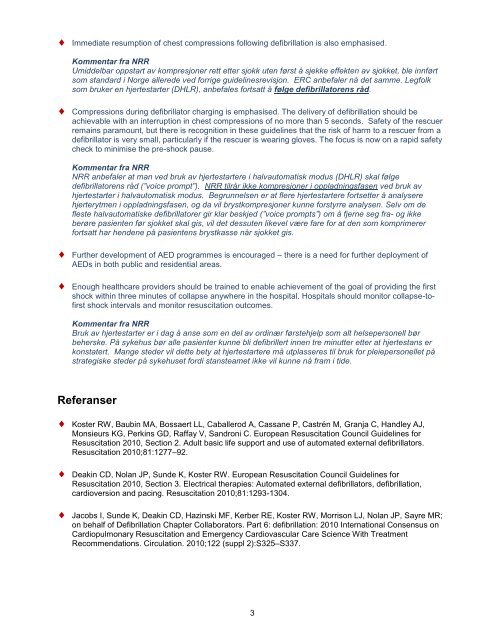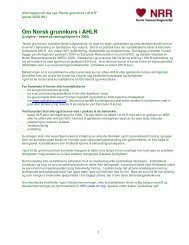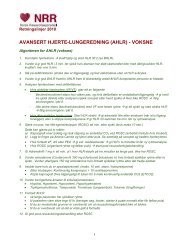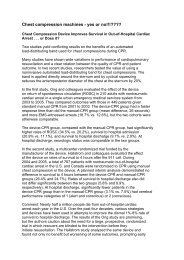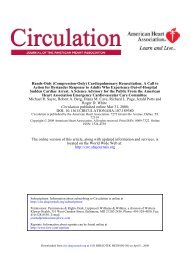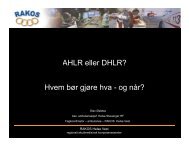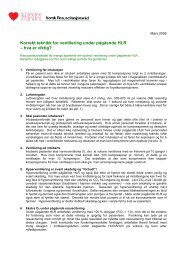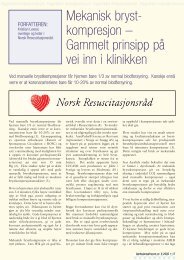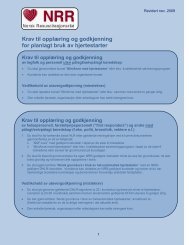DHLR retningslinjer 2010 - NRR
DHLR retningslinjer 2010 - NRR
DHLR retningslinjer 2010 - NRR
You also want an ePaper? Increase the reach of your titles
YUMPU automatically turns print PDFs into web optimized ePapers that Google loves.
Immediate resumption of chest compressions following defibrillation is also emphasised.Kommentar fra <strong>NRR</strong>Umiddelbar oppstart av kompresjoner rett etter sjokk uten først å sjekke effekten av sjokket, ble innførtsom standard i Norge allerede ved forrige guidelinesrevisjon. ERC anbefaler nå det samme. Legfolksom bruker en hjertestarter (<strong>DHLR</strong>), anbefales fortsatt å følge defibrillatorens råd. Compressions during defibrillator charging is emphasised. The delivery of defibrillation should beachievable with an interruption in chest compressions of no more than 5 seconds. Safety of the rescuerremains paramount, but there is recognition in these guidelines that the risk of harm to a rescuer from adefibrillator is very small, particularly if the rescuer is wearing gloves. The focus is now on a rapid safetycheck to minimise the pre-shock pause.Kommentar fra <strong>NRR</strong><strong>NRR</strong> anbefaler at man ved bruk av hjertestartere i halvautomatisk modus (<strong>DHLR</strong>) skal følgedefibrillatorens råd (”voice prompt”). <strong>NRR</strong> tilrår ikke kompresjoner i oppladningsfasen ved bruk avhjertestarter i halvautomatisk modus. Begrunnelsen er at flere hjertestartere fortsetter å analyserehjerterytmen i oppladningsfasen, og da vil brystkompresjoner kunne forstyrre analysen. Selv om defleste halvautomatiske defibrillatorer gir klar beskjed (”voice prompts”) om å fjerne seg fra- og ikkeberøre pasienten før sjokket skal gis, vil det dessuten likevel være fare for at den som komprimererfortsatt har hendene på pasientens brystkasse når sjokket gis. Further development of AED programmes is encouraged – there is a need for further deployment ofAEDs in both public and residential areas. Enough healthcare providers should be trained to enable achievement of the goal of providing the firstshock within three minutes of collapse anywhere in the hospital. Hospitals should monitor collapse-tofirstshock intervals and monitor resuscitation outcomes.Kommentar fra <strong>NRR</strong>Bruk av hjertestarter er i dag å anse som en del av ordinær førstehjelp som alt helsepersonell børbeherske. På sykehus bør alle pasienter kunne bli defibrillert innen tre minutter etter at hjertestans erkonstatert. Mange steder vil dette bety at hjertestartere må utplasseres til bruk for pleiepersonellet påstrategiske steder på sykehuset fordi stansteamet ikke vil kunne nå fram i tide.Referanser Koster RW, Baubin MA, Bossaert LL, Caballerod A, Cassane P, Castrén M, Granja C, Handley AJ,Monsieurs KG, Perkins GD, Raffay V, Sandroni C. European Resuscitation Council Guidelines forResuscitation <strong>2010</strong>, Section 2. Adult basic life support and use of automated external defibrillators.Resuscitation <strong>2010</strong>;81:1277–92. Deakin CD, Nolan JP, Sunde K, Koster RW. European Resuscitation Council Guidelines forResuscitation <strong>2010</strong>, Section 3. Electrical therapies: Automated external defibrillators, defibrillation,cardioversion and pacing. Resuscitation <strong>2010</strong>;81:1293-1304. Jacobs I, Sunde K, Deakin CD, Hazinski MF, Kerber RE, Koster RW, Morrison LJ, Nolan JP, Sayre MR;on behalf of Defibrillation Chapter Collaborators. Part 6: defibrillation: <strong>2010</strong> International Consensus onCardiopulmonary Resuscitation and Emergency Cardiovascular Care Science With TreatmentRecommendations. Circulation. <strong>2010</strong>;122 (suppl 2):S325–S337.3


